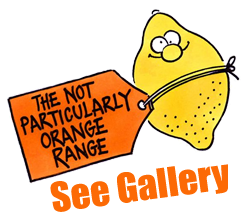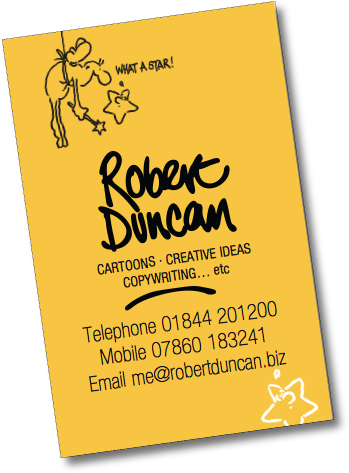Intro/pre-history/biogs
Frank Sinatra! Prince Charles! Sir Laurence Olivier! The Pope! Are among the people who probably didn’t send out Not Particularly Orange cards. And in spite of that they still became the most popular and fabulous range of greeting cards ever produced. Well, by that name anyway. So in response to numerous requests (thank you Brenda from Croydon and Eric in Calcutta) we present the Not Particularly Orange story. Here, in graphic detail, and often resorting to rude words, is an honest account of how this world beating card range came to be. There are so many samples, and so much self-indulgent crap that you will probably be bored by … um … just about now.
Read the pre-history first. Then you’ll know who you’re dealing with, and will be able to make a logical adult decision …
Pre-history
It all began one bright spring morning. Robert Duncan jumped out of bed, listened to the birds singing in his pyjamas, and donned … a suit. This was because he wanted to make a good impression to a greeting card company that had expressed an interest in his cartoons. Happy and eager, he rang the door bell …
The door was opened by a great gawky studenty type with very long hair and a cup of foul smelling tea. Or was it a very long cup of tea and foul smelling hair? The memory plays tricks.
“Robert Duncan?” this fellow uttered. Who was he expecting? Harold Wilson? Obviously taken aback and slightly horrified by the advanced age of his new artistic discovery, David Hix, for that is who this Neil from The Young Ones Lookalike was, remembered his manners just in time and said “Tea?”
Well, as you can imagine, Robert Duncan was not used to such kindness, so warmed to this odd specimen immediately. Questioning to himself why he had worn the good suit when the greeting card company turned out to be nothing more than this bloke’s lounge, with some hastily built shelves, or ‘stock’ as his host referred to it.
In the throes of this unlikely beginning, Robert Duncan and Hix cracked a deal and, more importantly, a joke or two. RD loosened his tie and wished he was twenty years younger. Hix loosened his hair band and wished he could afford Gerald Scarfe.
And Robert Duncan left, having agreed to do six cards because at least he would have a few samples to send to his chums, and the whole bloody morning wouldn’t have been completely wasted.
The result, a curious card collection called Terribly Useful Cut-outs, were a complete disaster. The second meeting, when the Hix visited RD on his own patch, was no more encouraging.
Hix wanted to try cartoon postcards and RD suggested keeping them VERY simple (so not too much effort) and … that they should be typeset captions. Hix said no, but it was agreed to have RD’s own hand lettering, and black and white cartoons with a minimal bit of second colour – red, blue, green or yellow.
After deep discussion, and upwards of three rejected titles, it was decided to call the cards The Not Particularly Orange Range – on the grounds that orange wasn’t being used in the printing.
Anyway, to cut a long story short (if it’s not too late) RD did the first six cards. Hix went away and came back a month later with printed samples, the lines for a dozen more cards, and a royalty cheque made out to Robert Duncan for £250.
RD, now galvanized into extreme interest, produced the next cartoons at high speed.
The working relationship developed into the old good pals scenario very quickly, and is still very much in existence today, nearly twenty years later, with jolly evenings out where RD drinks too much to drive, and takes hideous advantage of the Hix spare bed. This is mainly because, in those early days, they thought of each other as incredibly funny (even if no one else did) and would send rude and unnecessary faxes to each other deep into the night. Samples still exist – literary gems that feature words such as bum, tit and willy frequently.
David Hix and his Really Good Card Company suddenly moved into glitzy new surroundings, with a sea of desks containing waving members of staff, people hanging around the coffee machine, and chaps on fork lift trucks. Business was brisk, with orders flying around the world, via places like Athena, WHSmith and the Belgian Congo.
With the Not Particularly Orange range expanding all the time (it eventually reached over 300 cards) Hix set his sights on printing the Duncan genius on to folding cards. He was never anything less than inspirationally imaginative. The result was the Remarkable Duck range, quickly followed by the Big Balls range (don’t mention badge cards) the Casual Fish range, Ticky Bits, and the Serious Hyena range. But all that’s another story.
Hix and Duncan were giggling their way into the record books, which understandably irritated everyone else, and were soon developing spin-offs to maximize the impression that the Not Particularly Orange range had made on the public.
There were calendars. More calendars. Year planners. Badges. Cufflinks. T-shirts. Keyrings. Ties. Socks. A Mouse Nightshirt. Soap. Smelly knickers. Some dodgy creams. A Willy Nightcap with a bell on top, which Hix claims to have tested to destruction. Mousemats. Notebooks. Body Chocolate. Little cakes. More calendars. At its height the Not Particularly Orange range, and all that went with it, was deeply loved – especially by students – to the extent that it was hard to find a card shop between England and Australia that didn’t feature them in some way. The cards, not the students.
One day, David Hix looked at Robert Duncan and said “My God, if they knew how bloody old you are.” Robert Duncan was deeply touched.
But all good things come to an end, as one willy said to another, and this write-up is no exception. No exception whatsoever. No. This write-up is not an exception at all. Absolutely not.
It’s a write-up.






